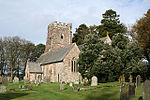Withypool Stone Circle

Withypool Stone Circle, also known as Withypool Hill Stone Circle, is a stone circle located on the Exmoor moorland, near the village of Withypool in the southwestern English county of Somerset. The ring is part of a tradition of stone circle construction that spread throughout much of Britain, Ireland, and Brittany during the Late Neolithic and Early Bronze Age, over a period between 3300 and 900 BCE. The purpose of such monuments is unknown, although archaeologists speculate that the stones represented supernatural entities for the circle's builders. Many monuments were built in Exmoor during the Bronze Age, but only two stone circles survive in this area: the other is Porlock Stone Circle. The Withypool ring is located on the south-western slope of Withypool Hill, on an area of heathland. It is about 36.4 metres (119 feet 5 inches) in diameter. Around thirty small gritstones remain, although there may originally have been around 100; there are conspicuous gaps on the northern and western sides of the monument. The site was rediscovered in 1898 and surveyed by the archaeologist Harold St George Gray in 1905.
Excerpt from the Wikipedia article Withypool Stone Circle (License: CC BY-SA 3.0, Authors, Images).Withypool Stone Circle
Portford Bridge,
Geographical coordinates (GPS) Address External links Nearby Places Show on map
Geographical coordinates (GPS)
| Latitude | Longitude |
|---|---|
| N 51.0963 ° | E -3.6604 ° |
Address
Withypool Stone Circle
Portford Bridge
TA24 7QU , Withypool and Hawkridge
England, United Kingdom
Open on Google Maps









